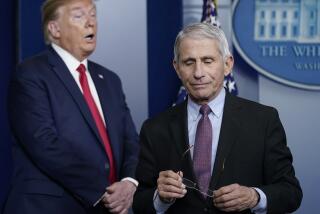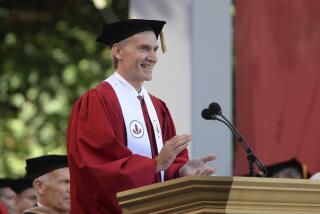Why Beauty of Scientific Models Is Often Only Skin Deep
- Share via
Scientific American is fine if you want the conventional wisdoms about global warming and earthquake prediction. But if you want an intuitive appreciation of how science is really done these days, pick up a copy of Vogue.
You’ll find a host of gorgeous models: blondes, brunettes and redheads who are alternately mysterious, provocative or demure. A few look good in anything, others look best in next to nothing. With the right makeup, lighting and layout, the ordinary model becomes an irresistibly alluring creature. The best of them command your attention, convey the right sensibility and sell the concept.
It’s exactly the same with scientists; it’s just that their models are built differently.
Unfortunately, scientific controversies increasingly revolve around the relative sexiness of the models. Take global warming, please. Those media-hyped models do many things but they don’t explain what’s going on in the atmosphere. Our understanding of fundamental forces is poor, our data incomplete. What these models really are is an attempt to explain what we think is going on. It’s not hard science. They aren’t descriptions, they’re conjectures. Some of these conjectures merit serious attention. But to treat them as models of reality, as a few vocal scientists, journalists and politicians do, is dishonest and reeks of political or personal agendas.
Too many scientists have fallen in love with their models. The result is that science in the public policy arena today looks less like an objectively rigorous discipline than a sleazy beauty contest. The models are being used to bludgeon policy-makers into completely rewriting regulations on everything from energy to agriculture. Conversely, politicians are grasping these models to push their platforms.
“It’s become a circus atmosphere,” says Richard Linzden, a Massachusetts Institute of Technology meteorologist and a critic of several models that purport to show that the Earth is heating up. “One of the odd things I’ve discovered with these models is that, if you look at these groups, you have one person who is the administrator--and he is usually the one making the loudest proclamations. Then you have the people who actually run the model and they make much more sober and balanced remarks when they’re talking at workshops.”
What’s happening is alchemy of the worst kind: When science mixes with politics, it becomes political science. Scientists trade objectivity for advocacy. “When one makes an intellectual commitment to a position, that makes it important to prove one is right,” says James Schlesinger, the former energy and defense secretary noted for his skill at wielding technical models for political effect.
“There is no question that politics must put you on a limb,” says MIT’s Linzden. “What was previously fun and games suddenly forces you to exaggerate because you know that others are.”
The bottom line is that too many scientists are squandering their credibility to peddle equations that predict the future less reliably than a coin toss. As Harvard’s Harvey Brooks, widely regarded as the dean of technology policy analysis, puts it, “The more clear-cut the answer gets, the more dishonest the scientist is usually being.” In other words, we’re coming to the point where the integrity of the model is less important than the integrity of the scientist. That’s not science, it’s lobbying.
It’s not that scientists aren’t sincere about the legitimacy of their models--it’s that most of these models are only good as models; they’re too brittle and flimsy to build a meaningful policy around. The techno-gamesmanship that goes on in the media and Congress is as much a byproduct of ignorance as cynical manipulation. People think that these models actually say something important; in practice, they’re like an infant struggling to mouth a sentence.
“Technically speaking,” says Schlesinger, “(scientific modelers) should be saying that their models aren’t only imprecise--but they have no way of knowing how much in error they may be.”
The same holds true for earthquake prediction. Seismologists do a superb job of understanding the G-forces that shock waves unleash; they do a miserable job of predictive modeling for how the Earth moves. Why? Because, as Oct. 17 confirmed, our understanding of the labyrinth of faults isn’t good enough. There is a universe of difference between modeling systems we understand--such as telephone networks and silicon chips--and modeling systems we think we understand, such as the atmosphere, Earth and stock market. It’s the difference between cause and effect.
Let me put it another way. If scientists could reliably model the future, they wouldn’t need to keep asking for money--they’d be rolling in dough.
The appropriate role of scientific models isn’t to define the public debate--which is what they’re doing now--but to expand the vocabulary of that debate. These models are adjectives and adverbs, not subjects and verbs. Treat models for what they are: a point of view, not a trend about to become our destiny.
Scientists who testify before Congress and talk to the media should have the guts to admit what they don’t know instead of spouting inanities such as “the polar ice caps may or may not melt half an inch by 1999.” It’s no sin to passionately defend the quality of one’s work; but it is no virtue to pimp models for policy purposes.
Harry Truman once wished for “one-handed scientists”--scientists who wouldn’t always say “On one hand . . . but on the other hand”--but there’s a difference between equivocation and context. I’m not worried about finding scientists with strong opinions and even stronger data. I’m worried about finding scientists who can put those strengths in contexts that the public and policy-makers can use. Scientific models don’t exist to persuade--they exist to enhance understanding.
While I strongly question the multiple models surrounding the greenhouse effect, I think it’s beyond dispute that there is a rising buildup of gases in the atmosphere. Intuition suggests that this probably isn’t a good thing. Common sense suggests that this phenomenon merits careful study. People who care about our planet should welcome all the ideas, data and models we can generate to figure out what’s going on. People who care about the truth shouldn’t be afraid to acknowledge that it takes a lot of mistakes to get there.






